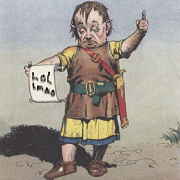- Hubbert
- Mar 25, 2007
-

At a time of universal deceit, telling the truth is a revolutionary act.
|
You can still be a doomer and realize that while individual actions do not matter to the planet wide problem, they do matter to you, the individual.

and now, for some actual non-mainstream academic content, because this thread has been too happy for too long
For most of human history, about 300,000 years, we lived as hunter gatherers in sustainable, egalitarian communities of a few dozen people. Human life on Earth, and our place within the planet’s biophysical systems, changed dramatically with the Holocene, a geological epoch that began about 12,000 years ago. An unprecedented combination of climate stability and warm temperatures made possible a greater dependence on wild grains in several parts of the world. Over the next several thousand years, this dependence led to agriculture and large-scale state societies. These societies show a common pattern of expansion and collapse. Industrial civilization began a few hundred years ago when fossil fuel propelled the human economy to a new level of size and complexity. This change brought many benefits, but it also gave us the existential crisis of global climate change. Climate models indicate that the Earth could warm by 3°C-4 °C by the year 2100 and eventually by as much as 8 °C or more. This would return the planet to the unstable climate conditions of the Pleistocene when agriculture was impossible.
[...]
Anatomically modern humans, Homo sapiens, have inhabited the earth for more than 300,000 years (Stringer & Galway-Witham,2017). For at least 97 % of this time our hunter-gatherer ancestors lived as many other large predators do, in small groups within the confines of local ecosystems (Diamond, 1987; Gowdy, 1998; Ponting, 2007). Human populations grew and shrank with changes in climate and food resources flowing directly from the natural world—from the hundreds of plants and animals they depended on. Human life on Earth, and our place within that web of life, changed dramatically during the Holocene, a geological epoch that began about 12,000 years ago. An unprecedented combination of climate stability and warm temperatures made possible a greater dependence on wild grains in several parts of the world. Over the next several thousand years, this growing dependence led to agriculture and large-scale state societies (Gowdy & Krall, 2014). It took only a few thousand years after sedentary agriculture began for it to spread and become dominant in the Middle East, South Asia, China, and Mesoamerica. Within that relatively short time period, agriculture caused the world human population to explode from 4 to 6 million to over 200 million by the beginning of the Common
Era (CE) 2000 years ago (Biraben, 2003).
The adoption of agriculture made the average person worse off for millennia. Physical health declined dramatically and most of the world’s people were born into rigid caste systems and lived as virtual or actual slaves. According to Larsen (2006 p. 12): “Although agriculture provided the economic basis for the rise of states and development of civilizations, the change in diet and acquisition of food resulted in a decline in quality of life for most human populations in the last 10,000 years.” After agriculture, humans became shorter and less robust and they suffered from more debilitating diseases, from leprosy to arthritis to tooth decay, than their hunter-gatherer counterparts (Cohen & Crane-Kramer, 2007). It is only in the last 150 years or so that the longevity, health, and well-being of the average person once again reached that of the Upper Pleistocene. The average human life span in 1900 was about 30 years, and for Upper Pleistocene hunter-gatherers it was about 33 years. 1 Given the predicted dire economic consequences of climate change and biological annihilation, it is doubtful that these improvements can be maintained. Care must be taken not to see the achievements of the very recent past as representative of the health and well-being consequences of the agricultural revolution.
Agriculture and civilization were possible because of the unusually warm and stable climate of the Holocene. Before then, year-to-year variations in temperature and rainfall made agriculture too undependable to support settled communities with large populations. The Earth’s climate has been unusually stable for about 10,000 years. But with the human-caused increase in CO 2 levels we have locked ourselves into a new period of climate instability that scientists predict will be comparable to the conditions of the Pleistocene. During that epoch, climate changes from warm periods to ice ages were triggered by swings in atmospheric CO 2 levels of about 50 ppm around the average of 250 ppm. The temperature variations were about 4 °C from the average. In just the past 70 years human activity has increased atmospheric CO 2 levels by 100 ppm to over 400 ppm, and the Earth’s average temperature has warmed by 1 °C. Unless draconian measures are taken to halt the increase in atmospheric CO 2 , global temperature will likely increase by at least 3 °C above today’s by the year 2100 and could eventually increase by 8 °C or more (the so-called mega-greenhouse). Given the large human population, the likely effects of climate change on economic and social stability, and the potential fragility of the world’s industrial agricultural system, it is unlikely that human civilization can survive the coming mega-greenhouse. The prospect of civilization collapse has now entered the mainstream of scientific and popular discourse (BBC, 2019; Diamond, 2019; Spratt & Dunlop,2019). In the discussion below, the period two to three centuries in the future is used as a general reference point for the ultimate effects of human-caused climate changes. This long-term view avoids the quagmire of the “immediate collapse” versus the “peak and decline” discussions (2012, Randers, 2008) and also gets us close to the likely ultimate business-as-usual peak of temperature and CO2 levels.
[...]
After agriculture, a second sea-change in economic and social organization came with the massive influx of fossil fuel energy that triggered the industrial revolution. Economic life was transformed from being predominantly agricultural to one dominated by manufacture, trade and finance (Hall & Klitgaard, 2011). Fossil fuel energy is flexible, storable and transportable and it transformed every aspect of human society from an individual’s capacity to perform work to global population size. Fossil fuel has also transformed the climate and locked us into ever more complex and fragile agricultural, industrial and financial systems. It also depends on the stability of global markets and economic institutions, and on the ability of complex technologies to respond quickly to a variety of climatic and biological threats. Our industrial agriculture system is dependent on the relative climate stability of the Holocene and on abundant and readily accessible fossil fuels, the main source of climate destabilizing CO2 .
[...]
Most statements about climate change use a phrase something like “since the industrial revolution the earth’s temperature has increased by 1 °C.” This is true but the alteration of the earth’s atmosphere by human activity is a very recent and rapid phenomenon. Most of the 1 °C increase in the earth’s average temperature since pre-industrial times has occurred since 1980. Most of the increase in atmospheric CO 2 (from about 310 ppm–410 ppm) has occurred since 1950. 75 % of fossil fuel burning and anthropogenic CO 2 in the atmosphere has occurred since 1970. The effects of anthropogenic CO 2 emissions are just beginning to be felt. Climate change projections are increasingly alarming as they become more accurate by, for example, refining the effects of sunlight reflected by clouds as the earth warms, and modifying projections using past warming events to calibrate the interactions among CO 2, temperature, sea level rise, and feedback effects. 2 Brown and Caldeira (2017) suggest that there is a 93 % change that temperature increases will exceed 4 °C by the end of this century. A report by the World Bank (2012 p. xiii) warns:
Without further commitments and action to reduce greenhouse gas emissions, the world is likely to warm by more than 3 °C above
the preindustrial climate. Even with the current mitigation commitments and pledges fully implemented, there is roughly a 20
percent likelihood of exceeding 4 °C by 2100. If they are not met, a warming of 4 °C could occur as early as the 2060s. Such a
warming level and associated sea-level rise of 0.5–1 meter, or more, by 2100 would not be the end point: a further warming to
levels over 6 °C, with several meters of sea-level rise, would likely occur over the following centuries.
The IPCC (2014) median no-aggressive-policies, high emissions projection for 2100 is a warming of 4 °C (RCP8.5). The current lack of effective policies to deal with climate change, even in the face of increasingly dire warnings, suggests that high emission projections provide the most accurate climate change scenarios (Gabbatiss, 2017). The IPCC optimistic scenarios (RCP2.6, RCP4.5) assume not yet feasible geoengineering schemes to remove atmospheric CO2. Annual emissions have increased significantly since the Kyoto Protocol twenty years ago. No major industrial country is on track to meet the commitments of the (very modest) Paris agreement (Wallace-Wells, 2017). It seems unlikely that the policies required to keep warming at manageable levels will be implemented in time to avoid catastrophic climate change.
The very long-term consequences of climate change have received relatively little attention (Bala, Caldeira, Mirin, Wickett, & Delire, 2005; Gowdy & Juliá, 2010; Kasting, 1998). Most projections of global warming focus on either the year 2100 or the effects of a doubling of CO 2 (from the pre-industrial level of 275 ppm–550 ppm). The lack of attention to the very long run is a serious shortcoming, since integrated carbon-climate models project that if CO 2 from current in situ fossil fuel resources continues to be released into the atmosphere, the peak concentration of atmospheric CO 2 could exceed 1400 ppm by the year 2300 and the average global temperature could warm by 8 °C or more (Bala et al., 2005; Kasting, 1998). A CO 2 level of 1400 ppm would increase the risk of a rise in temperature as high as 20 °C which will certainly have catastrophic consequences for all life on Earth. It is sobering to consider that current levels of CO 2 are higher than at any time in the last 15 million years (World Bank, 2012 p. xiv).
The main policy-relevant variable for the Earth’s temperature is the amount of CO 2 in the atmosphere. The human contribution to CO2 increases is largely the result of fossil fuel burning. Unless coupled with policies to leave fossil fuels in the ground, other energy sources will merely supplement, not replace fossil fuels. Future increases in total atmospheric CO 2 depend primarily on the total amount of fossil fuel carbon burned. Accessible fossil fuel carbon—mostly coal—is so vast that if burning continues, currently feasible mitigation options such as moderately reducing CO 2 emission rates, limited sequestration, and re-forestation will have a negligible effect on the ultimate atmospheric concentration of CO2 (Caldeira & Kasting, 1993; Matthews & Caldeira, 2008). Even if climate change mitigation policies reduce CO 2 emission rates, atmospheric CO 2 concentrations will continue to rise until emissions fall to the natural removal rate. Much of the emitted CO 2 remains in the atmosphere centuries or even millennia after its release. Archer (2005) suggests that 300 years is a good average lifetime number for CO2 and that 17–33 % of the CO 2 will remain in the atmosphere 1000years after it is emitted. Montenegro, Brovkin, Eby, Archer, and Weaver (2007) suggest that released carbon may stay in the atmosphere an average of 1800 years or longer. According to Archer & Brovkin (2008 p. 283): “Ultimate recovery takes place on time scales of hundreds of thousands of years.” The effects of fossil fuel burning are irreversible on a time scale relevant to humans.
[...]
With the future climate instability already locked into the system by recent human activity we will most likely return to the climate volatility of the Pleistocene. Climate change will adversely affect agriculture in a number of ways including sea level rise, higher average temperatures, heat extremes, changes in rainfall patterns, and the loss of pollinators. Less understood changes include the effects on agricultural pests, soil composition, and the growth response of crops to rising CO 2 levels.

Fig. 2. Past temperature deviation from the mean and future projections. Source of Earth’s Climate 7.- Cenozoic IV-Holocene http://www.dandebat.dk/eng-klima7.htm
Fig. 2 shows the possible volatility in climate if the Earth returns to the climate regime of the last few thousand years of the Pleistocene. Future volatility will not, of course, follow exactly the same pattern but Fig. 2 represents a rough guess as to what might occur. Agriculture was impossiblein the past because of climate/weather instability and it is likely to again be impossible if similar conditions return.
Increased climate volatility could occur quite soon. According to Batissti (Quoted in Wallace-Wells, 2017):
By 2050, under a typical middle-of-the-road emissions scenario, you’re looking at a doubling of the volatility for grains in the mid-
latitudes. In places like China, the U.S., Europe, Ukraine—the breadbasket countries of the world—the volatility from year-to-year
just from natural climate variability at a higher temperature is going to be much higher. The impact on crops is going to be greater
and greater.
The ability of agriculture to adapt to climate change will depend on the rapidity of changes as well as their severity. Intensively growing high-tech crops on the massive scale required to support billions more people will be prohibitively expensive just in terms of the energy required. The feasibility of massively moving crops North to avoid warmer temperature is limited because of poor quality soils in places like northern Canada and Russia. Also, temperature fluctuations will be greater toward the poles. Much of the evidence is anecdotal, but there are already indications of climate instability more than offsetting the advantages of longer growing seasons in northern regions, For example, although longer summers in Greenland have increased the growing season by two weeks, they are becoming drier and rainfall has become more unpredictable with adverse effects on crops and livestock (Kintisch, 2016).
Sea level rise will be a major stress factor on agricultural output with the loss of agricultural land and increasing salinity from storm surges. According to Hansen et al. (2016): during the last interglacial, about 140,000 years ago, the earth was about 1 °C warmer than today and sea levels were 6–9 meters higher with evidence of extreme storms. Their modelling implies that a 2 °C warming would cause an eventual shutdown of the North Atlantic current, an ice melt in the North Atlantic and Southern oceans causing increased temperature gradients and more severe storms, and sea level rise of several meters within a very short time span of 50–150 years. Fischer et al. (2018 p. 474) write:
A global warming average of 1−2 °C with strong polar amplification has, in the past, been accompanied by significant shifts in
climate zones and the spatial distribution of land and ocean ecosystems. Sustained warming at this level has also led to substantial
reductions of the Greenland and Antarctic ice sheets, with sea-level increases of at least several meters on millennial timescales.
Wallace Broecker has called the ocean conveyer belt “the Achilles’ heel of the climate system” He estimates that were it not for the belt’s current course, average winter temperatures in Europe would drop by 20 degrees or more. According to him:
There is surely a possibility that the ongoing buildup of greenhouse gases might trigger yet another of these ocean re-organizations, and thereby the associated atmospheric changes.
Were this to happen a century from now, at a time when we struggle toproduce enough food to nourish the projected population of 12 billion to 18 billion, the consequences could be devastating.
(quoted in Smith, 2019).
Another threat to agriculture partially due to climate change, the loss of pollinators, is already underway (United Nations, FAO, 2019).
Increasing temperatures will have a devastating effect on agricultural productivity, especially given the sensitivity of grains to temperature extremes. It is estimated that 60 % of the calories consumed by humans come from just three grains, maize, rice and wheat. Modeling by Battisti & Naylor (2009 pp. 240-241) indicates a greater than 90 % probability that average growing season temperatures will exceed the most extreme seasonal temperatures recorded between 1900 and 2006 for most of the tropics and subtropics. During the record heat in Europe in Summer 2003, maize production fell by 30 % in France and 36 % in Italy. A 2008 study found that southern Africa could lose 30 % of its maize crop by 2030 due to the negative effects of climate change. Losses of maize and rice crops in South Asia could also be significant (Lobell et al., 2008).
Climate change will exacerbate social and political instability. It is difficult to establish a direct cause-and-effect relationship between climate change and social conflict, but the correlations are suggestive (Burke, Hsiang, & Miguel, 2015). The wars in Dafur and Syria and the massive migrations out of North Africa have been linked to droughts. The climatologist Michael Mann observed:
“The Syrian uprising was driven by another drought that was the worst drought on record—the paleo record suggests the worst in 900
years. Drought is a big one, it’s behind a lot of the conflict we see” (quoted in Wallace-Wells, 2017).
As climate change accelerates, migrations will be driven not only by drought, but also by sea level rise and the uninhabitability of much of South Asia and the Middle East because of extreme temperatures. Clark et al., 2016 p. 363) write: “Given that deglacial warming led to a profound transformation of Earth and ecological systems, the projected warming of 2.0–7.5 °C above the already warm Holocene conditions (at much faster rates than experienced during deglaciation) will also reshape the geography and ecology of the world.” Mass migration and the resulting conflicts over water and food will most likely destabilize future societies.
[...] Hubbert has issued a correction as of 02:12 on Apr 20, 2022
|


 valid point
valid point























































